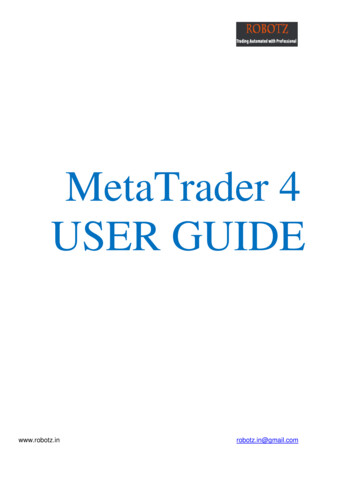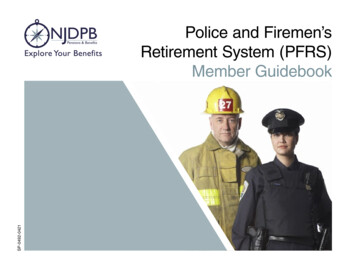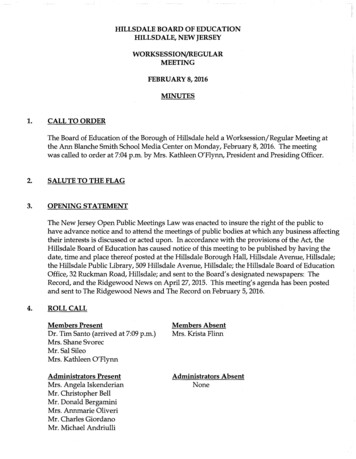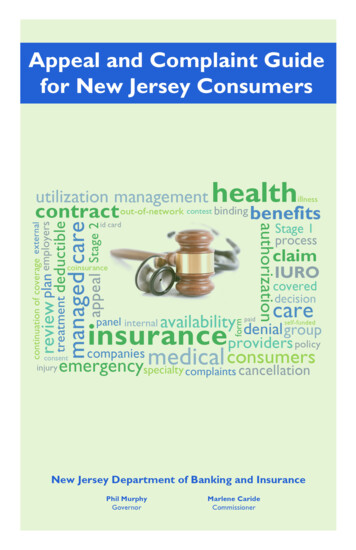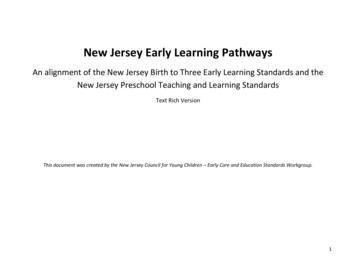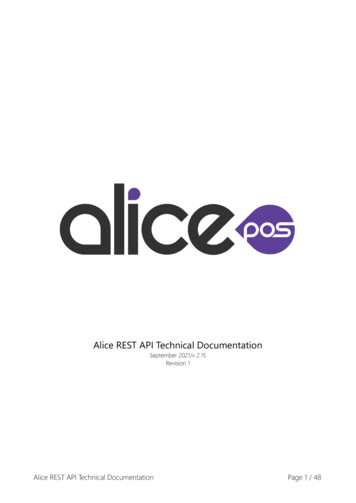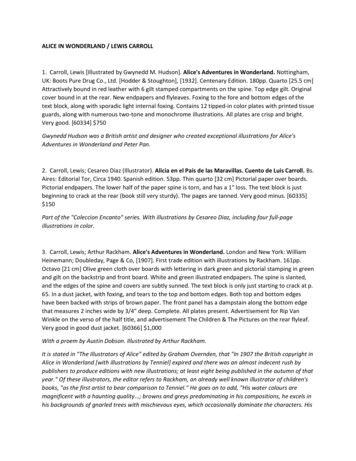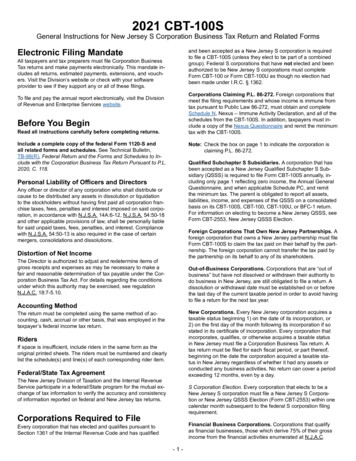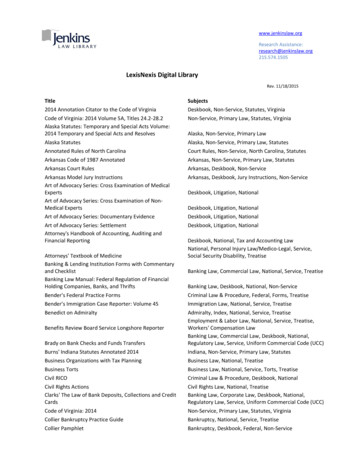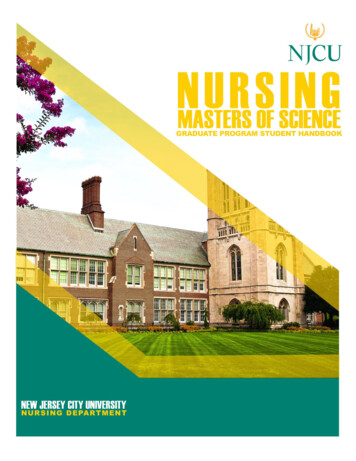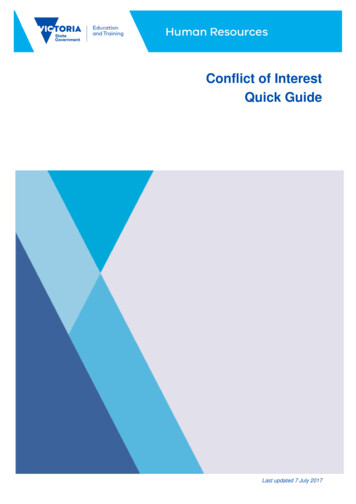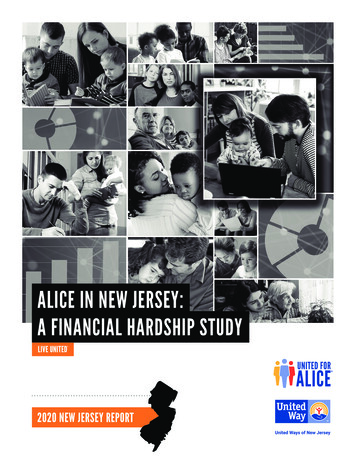
Transcription
ALICE IN NEW JERSEY:A FINANCIAL HARDSHIP STUDY2020 NEW JERSEY REPORT
ALICE IN THE TIME OF COVID-19The release of this ALICE Report for New Jersey comes during an unprecedented crisis — the COVID-19pandemic. While our world changed significantly in March 2020 with the impact of this global, dual health andeconomic crisis, ALICE remains central to the story in every U.S. county and state. The pandemic has exposedexactly the issues of economic fragility, widespread hardship, and growing disparities — particularly by raceand ethnicity — that United For ALICE and the ALICE data work to reveal.That exposure makes the ALICE data and analysis more important than ever. The ALICE Report for New Jerseypresents the latest ALICE data available — a point-in-time snapshot of economic conditions across the statein 2018. By showing how many New Jersey households were struggling then, the ALICE Research provides thebackstory for why the COVID-19 crisis is having such a devastating economic impact. The ALICE data is especiallyimportant now to help stakeholders identify the most vulnerable in their communities, and direct programmingand resources to assist them throughout the pandemic and the recovery that follows. And as New Jersey movesforward, this data can be used to estimate the impact of the crisis over time, providing an important baseline forchanges to come.This crisis is fast-moving and quickly evolving. To stay abreast of the impact of COVID-19 on ALICE householdsand their communities, visit our website at UnitedForALICE.org/COVID19 for updates.ALICE REPORT, 2020iNEW JERSEY
LETTER TO THE COMMUNITYDear Fellow New Jerseyans,For more than a decade, our United Way has been sounding the alarm about the growingnumber of working households that were being priced out of survival, vulnerable tofinancial devastation with just one emergency. Today, the crisis is here, and the COVID-19pandemic has laid bare the inequities that have been festering since the Great Recession.I invite you to join United Way in taking bold action. It’s time that every member ofour community — from government, business, and nonprofits to individuals — rise tothe challenge.We need a coalition that joins us in reimagining an ALICE-friendly workplace — one thatvalues all workers and their contributions, and ensures families have access to reliable,quality, and affordable child care. We cannot do this alone.ALICE workers are our grocery store clerks, child care workers, home health aides, and many of the essential workerswe’ve counted on during this dark time. We need these workers to be financially stable in order to get our economyback on track.You'll learn from this Report that low-income families systematically lost buying power and financial stabilityover the last decade as the high cost of essentials outpaced wages, driving the number of ALICE households inNew Jersey to rise by 41 percent.While this reality cuts across all ages and races, the data also reveals how long-standing inequities have contributedto Black, Hispanic, and single-female-headed households being disproportionately affected.While this report serves as a history lesson, it also presents an opportunity.Going back to normal will not be good enough. We must do better. United Way is putting the ALICE data into actionas a catalyst for positive, sustainable, long-term change. We are working toward a future where ALICE workers canafford to save for an emergency, access health care, and give their children the right start in life.To that end, we are leading a pilot project called United In Care, to rebuild how child care is delivered in our state tosupport today’s workforce and invest in the next generation of workers. We are joined in this effort by formidablephilanthropic organizations including the New Jersey Pandemic Relief Fund, Overdeck Family Foundation, DavidTepper Charitable Foundation Inc., and New Jersey Health Initiatives, to develop a sustainable model that can bereplicated across the state and country.And we are challenging business leaders through our ALICE Action Network to invest in policies and practices thatsupport ALICE workers — a strategy that can boost productivity and a company’s bottom line over the long term.United Way is committed to this work because we believe that by securing racial and economic equity for ALICE, wecan improve life for all in New Jersey. Visit our website at UnitedWayNNJ.org to learn how you can get involved tohelp ALICE.My challenge to everyone: How will you take action for ALICE?Kiran Handa GaudiosoChief Executive OfficerUnited Way of Northern New JerseyALICE REPORT, 2020iiNEW JERSEY
UNITED WAYS OF NEW JERSEYBergen County’s United WayUnited Way of BloomfieldUnited Way of Central JerseyUnited Way of Gloucester CountyUnited Way of Greater Mercer CountyUnited Way of Greater NewarkUnited Way of Greater Philadelphia and Southern New JerseyUnited Way of Greater Union CountyUnited Way of Hudson CountyUnited Way of Hunterdon CountyUnited Way of Monmouth and Ocean CountiesUnited Way of Northern New JerseyUnited Way of Passaic CountyUnited Way of Salem CountyLearn more about ALICE in New Jersey: UnitedWayNNJ.orgAcknowledgmentsUnited Ways of New Jersey thank our sponsors, partners, and community stakeholders throughout the state fortheir support and commitment to this 2020 ALICE Report for New Jersey. It is our hope that this Report will helpraise awareness of the 37% of households in the state who live in poverty or who are ALICE — Asset Limited, IncomeConstrained, Employed. Our goal is to inform and inspire policy and action to improve the lives of ALICE families.To learn more about how you can get involved in advocating and creating change for ALICE in New Jersey, contact:Molly Rennie, Molly.Rennie@UnitedWayNNJ.orgTo access the ALICE data and resources for New Jersey, go to UnitedForALICE.org/New-JerseyALICE REPORT, 2020iiiNEW JERSEY
ALICE RESEARCHALICE Reports provide high-quality, research-based information to foster a better understanding of who is struggling inour communities. To produce the ALICE Report for New Jersey, our team of researchers collaborated with a ResearchAdvisory Committee composed of experts from across the state. Research Advisory Committee members fromour partner states also periodically review the ALICE Methodology. This collaborative model ensures that the ALICEReports present unbiased data that is replicable, easily updated on a regular basis, and sensitive to local context.Learn more about the ALICE Research Team on our website at UnitedForALICE.org/ALICE-TeamDirector and Lead Researcher: Stephanie Hoopes, Ph.D.Research Support Team:Andrew Abrahamson; Ashley Anglin, Ph.D.; Catherine Connelly, D.M.H.; Max Holdsworth, M.A.; Dan Treglia, Ph.D.ALICE Research Advisory Committee for New JerseyJeffrey Backstrand, Ph.D.School of Public Affairs and Administration,Rutgers UniversityChris Kirk, Ph.D.Northwest New Jersey CommunityAction Partnership, Inc.Arnold CohenHousing and Community DevelopmentNetwork of New JerseyPatrick McGuinn, Ph.D., M.Ed.Drew UniversityLen PrestonNew Jersey Department of Labor andWorkforce DevelopmentAmy Davidow, Ph.D.School of Public Health,Rutgers UniversityJoseph Rubenstein, Ph.D.Stockton UniversityElizabeth Erbaugh, Ph.D.Stockton UniversityLaura A. Sullivan, Ph.D.New Jersey Institute for Social JusticeMichael Gerardi, M.D.Atlantic Health SystemDiane Wentworth, Ph.D.Fairleigh Dickinson UniversityAndrea Hetling, Ph.D.Edward J. Bloustein School of Planningand Public Policy, Rutgers UniversityQuintus Jett, Ph.D.School of Public Affairs and Administration,Rutgers UniversityALICE REPORT, 2020ivNEW JERSEY
ALICE: A GRASSROOTS MOVEMENTThis body of research provides a framework, language, and tools to measure and understand the struggles of apopulation called ALICE — an acronym for Asset Limited, Income Constrained, Employed. ALICE represents the growingnumber of households in our communities that do not earn enough to afford basic necessities. Partnering with UnitedWays, nonprofits, academic institutions, corporations, and other state organizations, this research initiative providesdata to stimulate meaningful discussion, attract new partners, and ultimately inform strategies for positive change.Based on the overwhelming success of this research in identifying and articulating the needs of this vulnerablepopulation, this work has grown from a pilot in Morris County, New Jersey to 21 states and more than 648 United Ways.Together, United For ALICE partners can evaluate current initiatives and discover innovative approaches to improve lifefor ALICE and the wider community. To access Reports from all states, visit UnitedForALICE.orgNorth ganIllinois asNew oMassachusettsNew YorkIowaNebraskaNevadaMaineWisconsinSouth DakotaIdahoNew HampshireVermontNorthCarolinaRhode IslandConnecticutNew JerseyDelawareMarylandDistrict ai‘iStates With ReportsNATIONAL ALICE ADVISORY COUNCILThe following companies are major funders and supporters of this work:Aetna FoundationCompare.com DeloitteRWJBarnabas HealthALICE REPORT, 2020Allergan Alliant EnergyEntergy AT&T Johnson & JohnsonRobert Wood Johnson Foundationv Atlantic Health System JLL Atlantic Union BankKaiser PermanenteThrivent Financial Foundation Key BankUPS U.S. VentureNEW JERSEY
WHAT’S NEW IN ALICE RESEARCHEvery two years, United For ALICE undertakes a full review of the ALICE Methodology to ensure that the ALICEmeasures are transparent, replicable, and current in order to accurately reflect how much income families needto live and work in the modern economy. In 2019, more than 40 external experts — drawn from the ResearchAdvisory Committees across our United For ALICE partner states — participated in the review process. A fulldescription of the Methodology and sources is available at UnitedForALICE.org/MethodologyThis Report includes the following improvements:More local variation: The ALICE budgets for housing, food, transportation, health care, and taxes incorporatemore local data. For housing, we differentiate counties within Metropolitan Statistical Areas using AmericanCommunity Survey gross rent estimates. For food, the U.S. Department of Agriculture’s Thrifty Food Plan isadjusted at the county level using Feeding America’s cost-of-meal data. For transportation, auto insurance isadded to new miles-traveled data (discussed in the next paragraph) to reflect different driving costs by state.For health care, out-of-pocket costs are provided by census region. And taxes now systematically include localincome tax, using data from the Tax Foundation.Better reflection of household composition: Transportation and health care budgets now better reflect costsfor different household members. The transportation budget for driving a car uses the Federal HighwayAdministration’s miles-traveled data, sorted by age and gender, and AAA’s cost-per-mile for a small or mediumsized car. The health care budget reflects employer-sponsored health insurance (the most common form in 2018,when it covered 49% of Americans1), using the employee’s contribution, plus out-of-pocket expenditures by ageand income, from the Agency for Healthcare Research and Quality Medical Expenditure Panel Survey.More variations by household size: The median household size in the U.S. is three people for householdsheaded by a person under age 65 and two people for households headed by seniors (65 ).2 Reflectingthis reality, the Household Survival Budgets are presented in new variations, including a Senior SurvivalBudget. The website provides data to create budgets for households with any combination of adults andchildren. The ALICE Threshold has also been adjusted to incorporate the most common modern householdcompositions. These new budget variations are included in the County Profile and Household Budget pageson UnitedForALICE.org/New-JerseyNew ALICE measures: The Senior Survival Budget more accurately represents household costs for people age 65 and over. Housingand technology remain constant; however, some costs are lower — transportation, food, and health insurancepremiums (due to Medicare) — while others are higher, especially out-of-pocket health costs. Because over 90%of seniors have at least one chronic condition, the Senior Survival Budget includes the additional cost of treatingthe average of the five most common chronic diseases. The ALICE Essentials Index is a standardized measure of the change over time in the costs of essentialhousehold goods and services, calculated for both urban and rural areas. It can be used as a companion to theBureau of Labor Statistics’ (BLS) Consumer Price Index, which covers all goods and services that families at allincome levels buy regularly.Data Notes: The data are estimates; some are geographic averages, others are one- or five-year averagesdepending on population size. Change-over-time ranges start with 2007, before the Great Recession, thenmeasure change every two years from 2010 to 2018. County-level data remains the primary focus, as stateaverages mask significant differences between counties. For example, the share of households below the ALICEThreshold in New Jersey ranges from 23% in Hunterdon County to 51% in Cumberland County. Many percentagesare rounded to whole numbers, sometimes resulting in percentages totaling 99% or 101%. The methodologicalimprovements included in this Report have been applied to previous years to allow for accurate year-over-yearcomparisons. This means that some numbers and percentages at the state and county level will not match thosereported in previous ALICE Reports for New Jersey.ALICE REPORT, 2020viNEW JERSEY
ALICE REPORT, 2020viiNEW JERSEY
TABLE OF CONTENTSAsset Limited, Income Constrained, Employed 1At-A-Glance: New Jersey 3Who Is ALICE? 5Trends: Household Demographics 7The Cost of Living in New Jersey 9The ALICE Household Budgets 9The ALICE Essentials Index 11Trends: Cost of Living 12The Changing Landscape of Work in New Jersey 14The New Labor Force 16ALICE Jobs: Maintaining the Economy 18Trends: The Landscape of Work 20Next Steps: Data for Action 22Identifying Gaps 22Understanding ALICE: Health, Education, and Social Factors 24The Benefits of Moving Toward Equity in New Jersey 25Endnotes 30Figure 12: Sources 41ALICE REPORT, 2020viiiNEW JERSEY
ASSET LIMITED, INCOME CONSTRAINED, EMPLOYEDFrom 2010 to 2018, New Jersey showed steady economicimprovement according to traditional measures.Unemployment in the state and across the U.S. fell to historiclows, GDP grew, and wages rose slightly. Yet in 2018, eightyears after the end of the Great Recession, 37% of NewJersey’s 3,248,970 households still struggled to make endsmeet. While 10% of these households were living below theFederal Poverty Level (FPL), another 27% — nearly three timesas many — were ALICE households: Asset Limited, IncomeConstrained, Employed. These households earned above theFPL, but not enough to afford basic household necessities.This Report provides new data and tools that explain thepersistent level of hardship faced by ALICE households,revealing aspects of the New Jersey economy not tracked bytraditional economic measures. The Report highlights threecritical trends:10%63%Poverty27%ALICEAbove ALICEThreshold The cost of living is increasing for ALICE households. From 2007 to 2018, the cost of household essentials(housing, child care, food, transportation, health care, and technology) increased faster than the cost of othergoods and services. The ALICE Essentials Index, a new tool that measures change over time in the cost ofhousehold necessities, increased at an average rate of 3.4% annually nationwide over the past decade, whilethe official rate of inflation was 1.8%. Worker vulnerability is increasing while wages stagnate in ALICE jobs. By 2018, a near-record-low number ofpeople were reported to be unemployed. However, that low unemployment concealed three trends that exposeALICE workers to greater risk: growth in the number of low-wage jobs, minimal increases in wages, and morefluctuations in job hours, schedules, and benefits that make it harder to budget and plan. These trends were clearin 2018: A record number of New Jersey workers — 43% — were paid by the hour, and 49% of the state’s jobs paidless than 20 per hour. The number of ALICE households has increased in New Jersey over the last decade as a result of rising costsand stagnant wages. There are more ALICE households than households in poverty, and the number of ALICEhouseholds increased at a faster rate. The FPL, with its minimal and uniform national estimate of the cost ofliving, far underestimates the number of households that cannot afford to live and work in the modern economy.In New Jersey, the percentage of households that were ALICE rose from 19% in 2007 to 27% in 2018. By contrast,those in poverty fluctuated between 9% and 11%, landing at 10% in 2018.This Report provides critical ALICE measures and research that provide an understanding of New Jersey’s economicstanding and unfolding trends from four perspectives: financial hardship over time and across demographic groups;the basic cost of living in New Jersey; jobs, wages, and employment dynamics; and gaps in assistance and communityresources. The ALICE measures also debunk assumptions and stereotypes about low-income workers and families.ALICE households are as diverse as the general population, composed of people of all ages, genders, races, andethnicities, living in rural, urban, and suburban areas.The Report concludes with an analysis of the benefits to the New Jersey economy if all households had income abovethe ALICE Threshold. Not only would there be a significant positive impact on families and their communities, but thestate economy would also benefit. In fact, the added value to the New Jersey GDP would be 97.9 billion.This Report and its measures are tools to help stakeholders ask the right questions, reduce vulnerabilities, removeobstacles to advancement, identify gaps in community resources, build a stronger workforce, and implement programsand policies that help put financial stability within reach for ALICE households. With the magnitude of financial hardshiprevealed, these actions can help move all households toward a more equitable economy, and ensure that no one is leftbehind in harder times.ALICE REPORT, 20201NEW JERSEY
GLOSSARYALICE is an acronym that stands for Asset Limited, Income Constrained, Employed — households with incomeabove the Federal Poverty Level but below the basic cost of living. A household consists of all the people whooccupy a housing unit. In this Report, households do not include those living in group quarters such as a dorm,nursing home, or prison.The Household Survival Budget estimates the actual bare-minimum costs of basic necessities (housing, childcare, food, transportation, health care, and a basic smartphone plan) in New Jersey, adjusted for different countiesand household types.The Senior Survival Budget incorporates specific cost estimates for seniors for food, transportation, and healthcare, reflecting key differences in household expenses by age.The Household Stability Budget calculates the costs of supporting and sustaining an economically viablehousehold over time, including a contingency for savings.The ALICE Threshold is the average income that a household needs to afford the basic necessities defined by theHousehold Survival Budget for each county in New Jersey. Households Below the ALICE Threshold include bothALICE and poverty-level households.The ALICE Essentials Index is a measure of the average change over time in the costs of the essential goods andservices that households need to live and work in the modern economy — housing, child care, food, transportation,health care, and a smartphone plan.ALICE ONLINEVisit UnitedForALICE.org for more details about ALICE, including:Interactive MapsData at the state, county,municipal, ZIP code, andcongressional district levelsDemographic DataInformation about ALICEhouseholds by age, race/ethnicity, and household typeCounty ProfilesDetailed data about ALICEhouseholds in each countyResearch AdvisoryCommitteeAdditional ReportsData SpreadsheetJobs GraphsDownload the ALICE dataDetails about where ALICEworksMethodologyMore AboutUnited For ALICELearn about the members androle of this critical groupOverview of the sources andcalculations used in the ALICEresearchExplore The ALICE EssentialsIndex and The Consequences ofInsufficient Household IncomeSee our partners, press coverage,learning communities, etc.Follow us on Facebook and Twitter @UnitedForALICEALICE REPORT, 20202NEW JERSEY
AT-A-GLANCE: NEW JERSEY2018 Point-in-Time DataPopulation: 8,908,520Number of Counties: 21Number of Households: 3,248,970How many households are struggling?10%ALICE, an acronym for Asset Limited, Income Constrained,Employed, comprises households that earn more thanthe Federal Poverty Level but less than the basic cost ofliving for the state (the ALICE Threshold). Of New Jersey’s3,248,970 households, 313,232 earned below the FederalPoverty Level (10%) in 2018, and another 865,196 (27%)were ALICE.63Poverty27%%ALICEAbove ALICEThresholdWhat does the New Jersey laborforce look like?A 2018 overview of the labor status of New Jersey’s 7,172,566 working-age adults (people age 16 and over) showsthat 65% of adults were in the labor force (blue bars), yet more than half were workers who were paid hourly. Hourlypaid jobs tend to have lower wages, fewer benefits, and less stability. In addition, 34% of adults were outside thelabor force (gold bars), either because they were retired or because they had stopped looking for work.Labor Status, Population Age 16 and Over, New Jersey, 2018Population Age 16 and Over 7.2 8%PartTimeHourly4,000,00019%Not in LaborForce - Other5,000,00015%Not in LaborForce - Retired6,000,0007,000,0008,000,000Note: Data for full- and part-time jobs is only available at the national level; these national rates (51% of full-time workers and 75% of part-time, hourly workers) have beenapplied to the total New Jersey workforce to calculate the breakdown shown in this figure. Full-time represents a minimum of 35 hours per week at one or more jobs for 48weeks per year. Many percentages are rounded to whole numbers, sometimes resulting in percentages totaling 99% or 101%.ALICE REPORT, 20203NEW JERSEY
What does it cost to afford the basic necessities?The average ALICE Household Survival Budget in New Jersey was 30,240 for a singleadult, 33,552 for a single senior, and 88,224 for a family of four in 2018 — significantlymore than the Federal Poverty Level of 12,140 for a single adult and 25,100 for afamily of four.Household Survival Budget, New Jersey, Average, 2018SINGLE ADULT2 ADULTS, 1 INFANT,1 PRESCHOOLERSENIOR (1 ADULT)Monthly CostsHousing 1,029 1,029 1,479-- 1,691Food 309 263 935Transportation 280 252 623Health Care 214 531 840Technology 55 55 75Miscellaneous 229 254 668Taxes 404 412 1,041 2,520 2,796 7,352 30,240 33,552 88,224 15.12 16.78 44.11Child CareMonthly TotalANNUAL TOTALHourly Wage**Full-time wage required to support this budgetNew Jersey Counties, 2018New Jersey Counties, 2018COUNTYTOTAL HOUSEHOLDS% ALICE 8%Union39,20835%WarrenCape 181,73830%Ocean228,62240%Passaic169,52148%ALICE REPORT, 2020TOTAL HOUSEHOLDS% ALICE 4237%Sources: Point-in-Time Data: American Community Survey, 2018. ALICEDemographics: ALICE Threshold, 2018; American Community Survey, 2018.Labor Status: American Community Survey, 2018; Federal Reserve Bank of St.Louis, 2018. Budget: AAA, 2018; Agency for Healthcare Research and Quality,2018; American Community Survey, 2018; Bureau of Labor Statistics, 2018—Consumer Expenditure Surveys; Bureau of Labor Statistics, 2019—ConsumerExpenditure Survey; Bureau of Labor Statistics, 2018—Occupational EmploymentStatistics; Centers for Medicare & Medicaid Services, 2016—Medicare CurrentBeneficiary Survey; Centers for Medicare & Medicaid Services, 2019; Centersfor Medicare & Medicaid Services, 2019—Medicare - Chronic Conditions; ChildCare Aware of America, 2019; Federal Highway Administration, 2017; FeedingAmerica, 2019; Fowler, 2019; Internal Revenue Service, 2020; Internal RevenueService—FICA, 2020; New Jersey Department of Human Services, Division ofFamily Development, 2018; Medicare.gov; Scarboro, 2018; The Zebra, 2018; U.S.Department of Agriculture, 2018—Official USDA Food Plans; U.S. Department ofHousing and Urban Development, 2018—Fair Market Rents; Walczak, 2019. Formore details, see the Methodology Overview at UnitedForALICE.org/Methodology4NEW JERSEY
WHO IS ALICE?With income above the Federal Poverty Level (FPL) but below a basic survival threshold — defined as the ALICEThreshold — ALICE households earn too much to qualify as “poor” but are still unable to make ends meet. They oftenwork as cashiers, nursing assistants, office clerks, servers, laborers, and security guards. These types of jobs are vitalto keeping New Jersey’s economy running smoothly, but they do not provide adequate wages to cover the basics ofhousing, child care, food, transportation, health care, and technology for these workers and their families.The total number of New Jersey households grew slowly, increasing 3%, from 3.1 million households in 2007 to 3.2million households in 2018. The number of households struggling financially increased at a much faster rate. Between2007 and 2018, the number of households in poverty increased by 16%, while the number of ALICE householdsincreased by 41%. Both groups increased the most during the Great Recession. The number of households in povertyrose from 269,318 in 2007 to 312,575 in 2010, then remained relatively flat through 2018, when they numbered 313,232and comprised 10% of the state’s households. ALICE households rose in number from 612,790 in 2007 to 865,196 in2018, with their share of New Jersey households increasing from 19% in 2007 to 25% in 2010 to 27% in 2018 (Figure 1).Overall, the percentage of households living below the ALICE Threshold (ALICE and poverty-level households combined)grew from 28% in 2007 to 35% in 2010, and then reached a high of 37% in 2012. And while the economy showed signsof recovery between 2012 and 2018, the share of households below the ALICE Threshold remained at 37% throughout,suggesting that households moving out of poverty were added to the ranks of ALICE, but few, if any, households movedabove the ALICE Threshold to financial stability.Figure 1.Households by Income, New Jersey, 0,000200,000100,0000PercentBelow 37%37%Sources: ALICE Threshold, 2007–2018; American
School of Public Affairs and Administration, Rutgers University Arnold Cohen Housing and Community Development Network of New Jersey Amy Davidow, Ph.D. School of Public Health, Rutgers University Elizabeth Erbaugh, Ph.D. Stockton University Michael Gerardi, M.D. Atlantic Health System Andrea Hetling, Ph.D. Edward J. Bloustein School of Planning
